The Leo Gomolchak Conservation Grants Program, named for Leo Gomolchak, a longtime CTU staffer and volunteer who worked tirelessly to promote wild and native trout restoration in Colorado helps benefit conservation efforts and organizational development at the chapter level by providing seed money which can be used as a starting point in financing grassroots conservation and/or education activities. This year at the 2018 Western Regional Rendezvous on Sunday, April 29, Keystone, CO, six projects across Colorado were awarded each $1300. Below are those recipients and their corresponding projects. Congratulations!
Boulder Flycasters: Trout in the Classroom and Watershed Education. The chapter, in collaboration with Lefthand and Fourmile Watershed groups, will establish four new Trout in the Classroom locations as part of a broader watershed education program to engage Boulder County students in watershed education and conservation.
The Greenbacks: Rock Creek / Black Canyon native trout. The Greenbacks are part of a multi-agency partnership to restore native greenback cutthroat trout in Rock Creek and its tributary Black Canyon (located in the upper Tarryall drainage). These funds will be part of the matching resources for construction of the final permanent barrier at the bottom of the total project. The Greenbacks will be holding a fall 2018 fundraiser with 100% of proceeds going toward this project, as additional matching resources for this grant.
Gunnison Angling Society: Adopt-a-Trout 2.0. Building on the well-received adopt-a-trout program conducted with Colorado Parks and Wildlife and Gunnison area students on Tomichi Creek, this project will involve area students in a similar monitoring effort to assess fish migration among Tomichi, Cochetopa and Quartz Creeks.
Southern Colorado Greenbacks: Trout in the Classroom. The Southern Colorado Greenbacks will help launch a new Trout in the Classroom site with a Pueblo-area middle school, where the partner teacher would use the program to engage her students with hands-on learning about nature including the understanding of water quality. The chapter will match Gomolchak Grant funds with proceeds raised through their Frostbite Fishoff.
St. Vrain Anglers: Trout in the Classroom. The St Vrain Anglers are will be bringing Trout in the Classroom to a Lyons elementary school. The Gomolchak Grant will help cover the initial capital costs for equipment, with the chapter than providing annual support to cover site operating costs as a match on this grant.
West Denver: RiverWatch. The West Denver Chapter is tackling a water quality monitoring project with RiverWatch on three sites along Clear Creek, including not just basic water chemistry but also macroinvertebrate sampling. One of the sampling events would be conducted in partnership with a Forest Service kids day education event on the Forest.
Contact David if you have any questions (dnickum@tu.org, or 303-440-2937 x1).










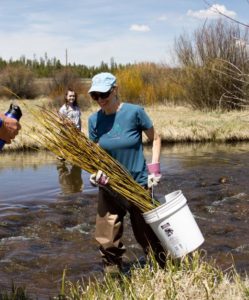 The group’s inaugural project at Fraser Flats aimed to restore a roughly one-mile stretch of the Fraser between the towns of Tabernash and Fraser, with the goal of providing healthy habitat for trout even during periods of reduced flows. The Fraser in this section had become too wide and shallow, resulting in sedimentation and high temperatures that smothered bug life and pressured coldwater-loving trout.
The group’s inaugural project at Fraser Flats aimed to restore a roughly one-mile stretch of the Fraser between the towns of Tabernash and Fraser, with the goal of providing healthy habitat for trout even during periods of reduced flows. The Fraser in this section had become too wide and shallow, resulting in sedimentation and high temperatures that smothered bug life and pressured coldwater-loving trout.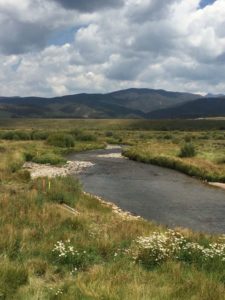 Colorado Parks and Wildlife conducted a fish survey on Oct. 5, shortly after completion of the project, and found dramatic increases in the biomass of brown and rainbow trout in the stretch compared to previous surveys, and an even larger increase in numbers of larger (14" and up) fish.
Colorado Parks and Wildlife conducted a fish survey on Oct. 5, shortly after completion of the project, and found dramatic increases in the biomass of brown and rainbow trout in the stretch compared to previous surveys, and an even larger increase in numbers of larger (14" and up) fish. CPW set up at the Zimmerman Lake inlet to capture spawning Greenbacks.
CPW set up at the Zimmerman Lake inlet to capture spawning Greenbacks. Fish were collected with a large net and put into a pen to be sorted and categorized by CPW staff and volunteers.
Fish were collected with a large net and put into a pen to be sorted and categorized by CPW staff and volunteers.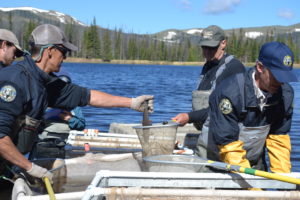 Fish were sorted based on their gender and stocking year.
Fish were sorted based on their gender and stocking year.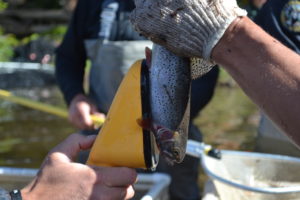 RFID chips in the fish help to identify the stocking year and other critical data.
RFID chips in the fish help to identify the stocking year and other critical data.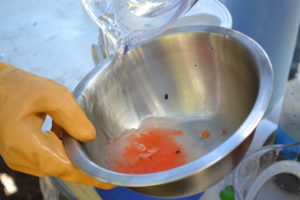 After the fish were sorted, CPW milked the males and females - making targeted genetic crosses among the various lineages to expand the genetic diversity. The eggs and sperm were combined in bowls, packed into small coolers, put on ice, and shipped to the local fish hatchery in Leadville, CO for breeding.
After the fish were sorted, CPW milked the males and females - making targeted genetic crosses among the various lineages to expand the genetic diversity. The eggs and sperm were combined in bowls, packed into small coolers, put on ice, and shipped to the local fish hatchery in Leadville, CO for breeding. Back in the 1960’s planners thought that Aspen’s population (1,101 in 1960) would reach 30,000 by the end of the century and that additional water supplies would be necessary. Aspen’s population didn’t grow much. In 2000 it was up to 5,914 and by 2010 had added less than a thousand more. Looking forward, the City’s population isn’t expected to grow much more over the next 60 years either, yet Aspen continues to hang on to the notion that they might, someday, need these destructive dams and reservoirs.
Back in the 1960’s planners thought that Aspen’s population (1,101 in 1960) would reach 30,000 by the end of the century and that additional water supplies would be necessary. Aspen’s population didn’t grow much. In 2000 it was up to 5,914 and by 2010 had added less than a thousand more. Looking forward, the City’s population isn’t expected to grow much more over the next 60 years either, yet Aspen continues to hang on to the notion that they might, someday, need these destructive dams and reservoirs.
